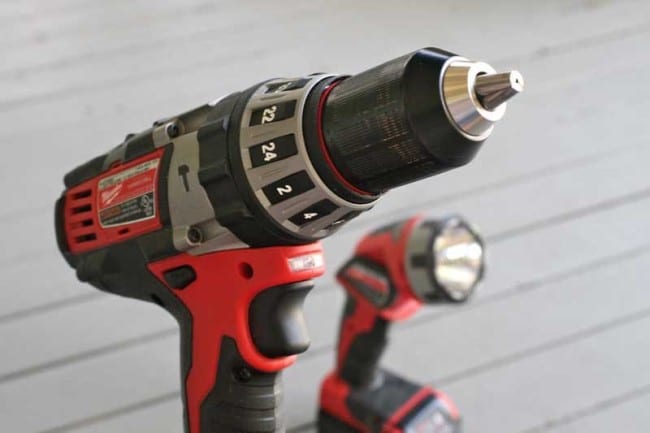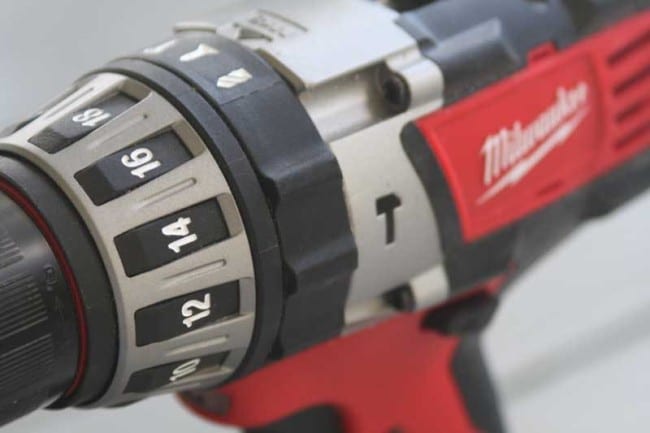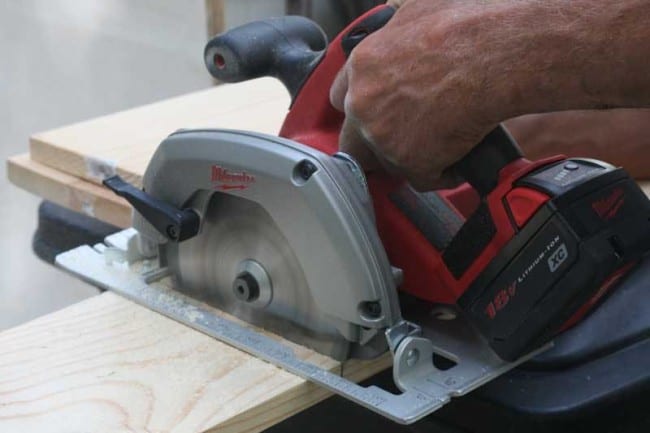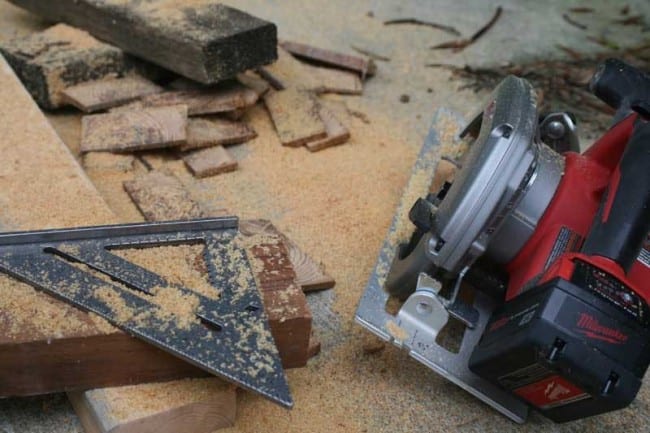The Milwaukee M18 Combo Kit came to us in a rather large box. And rightfully so, since it included a hammer drill, cordless circular saw, 18V reciprocating saw and a work light. That’s a lot of tools to jam into any container, and we were more than a little anxious to get everything unpacked and get to work. For several of these tools this was the second time we had handled them, thanks to the Milwaukee New Tools Symposium we attended back in June. This time, however, we had more time to test out each tool thoroughly and, more importantly, line up our own suite of torture tests and challenges. From the get-go, we noticed a lot of metal. Between the hammer drill and the circular saw, the amount of aluminum and magnesium was impressive. These are not light-duty tools and the construction quality lets that show – even before you feel the heft of each product.
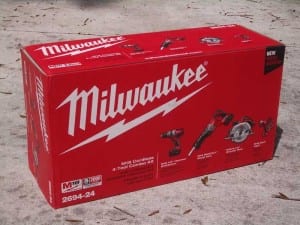
M18 Cordless 1/2″ Hammer-Drill/Driver (2602-20)
- Chuck Size: 1/2″ single sleeve keyless
- Clutch: 24 Position
- Mode switch: Drill/Driver/Hammer-Drill
- No Load RPM Low: 0-450
- No Load RPM High: 0-1,700
- BPM: 0-7,650/0-29,000
- Torque: 550 in/lbs (XC); 450 in/lbs (Compact)
- Weight: 5lb 1oz (with XC battery)
It’s important to note two things about this hammer drill (model 2602-20) before we start: First, it’s incredibly powerful and extremely well-built. Second, Milwaukee makes another M18 model, the 2611-24 that has an additional 100 ft/lbs of torque beyond this monster. I’m not sure we can even imagine that kind of power in an 18V system. The two can be told apart by the presence of red numbers on the clutch of the heavier duty model. This one has white numbers. It also doesn’t include the removable handle, but you can certainly pick one up as it has the same form factor, allowing it to be attached if present.
When we picked up the Milwaukee 2602-20 M18 hammer-drill we noticed it had some serious heft. Weighing in at just under 5 lbs, this is not a light-duty model that you’ll want to reserve for fixing bicycles and pre-drilling holes for shelves. This is a serious tool that can stand up to commercial use. It’s also considerably lighter than Milwaukee’s V28 line of tools – which makes it a good fit for pros who want as much power as they can garner without having to look like Vin Diesel to carry the tool around all day long. Of course, who am I fooling… until the last couple of years NiCd batteries added considerable weight to these tools and offered much less power for their bulk. The former V18 model weighed in a 6.2 lbs. Isn’t progress wonderful?
The body is marked by Milwaukee’s signature red ABS plastic and there is an abundance of black rubber overmold all over the tool for a comfortable and non-slip grip. I think it’s safe to say you could dip your hands in a jar of petroleum jelly and not lose your grip on this drill.
The Milwaukee M18 hammer-drill has excellent balance. I can describe it by telling you that if you hold the tool in your right hand and then open up your fingers, the tool will sit, tipping neither forward or back, in the “shelf” of your middle finger just below the trigger. That’s perfect balance. And it sends the weight of the tool straight downward where it belongs. Forward and reverse controls are easily bumped with your thumb and index fingers and we especially like it when manufacturers opt for a separate drill/driver/hammer mode switch. In the case of the 2602-20, it exists as a ring that sits just behind the clutch, allowing for easy engagement and disengagement of the hammer function and clutch system. Speaking of the clutch, there are 24 available settings, which is about the maximum number before entering the world of the ludicrous. Adjustments are made by spinning the collar and an audible and tactile click is emitted at each registered mark – which gave the function a reassuring feel.
The chuck is a 1/2″ all-metal single sleeve ratcheting style that should stand up to years of use and abuse. We found it quite easy to change bits, though one snag we located early on was that there was simply no place to store bits on the tool itself. As this is such an easy (and useful) thing to add it seemed like a silly oversight, though Milwaukee offers a bit holder and belt hook as aftermarket service parts. On top of the tool is the speed switch. This switch, along with the drill/driver mode switch and the clutch collar are all easily actuated with gloved hands. Indeed they seemed to be specifically made to accommodate them.
We tore into a lot of materials with the hammer-drill, including taking it to a solid wood exterior door that required a hole saw for adding a deadbolt. The torque and speed this tool afforded was nothing short of astounding. In terms of noise, the 2602-20 put out 86dB in High speed mode on its own. In terms of rotation, we measured a maximum of 1390 rpm in High speed and 386 rpm in Low – about 84% of the rated specs on average. On our cinder block test, the hammer-drill function tore through the sample like butter with our carbide-tipped masonry bit. Driving screws was a pleasure with the driver, offering tons of speed and also presenting plenty of torque control through the clutch system.
M18 Cordless Sawzall Reciprocating Saw (2620-20)
- No Load SPM: 0-3,200
- Stroke Length: 1″
- Weight: 8lb (with XC battery)
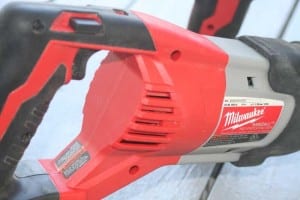
If you haven’t yet figured this out, Milwaukee made this cordless model to approach the same power as its corded offerings. That’s a tall order, so it was with great anticipation that we hit the test bench and lined up some wood and other materials to cut. We started with a standard 2×4. The M18 Sawzall took to it with gusto and sliced off piece after piece. With this tool, the blade is going to make all the difference. We preferred the rougher, demo blades when cutting through rough 2×4 material for demo work, but a finer general-purpose blade (included with the saw) was just fine for handling PVC and even slicing through thinner wood. The M18 Cordless Sawzall Reciprocating Saw even made mincemeat out of some old growth pine and allowed us to, with the included blade, hack our way through some finish nails that had been nestled in a trim board we were slicing through. Pick up a few blades, including one for metal, and this saw will work wonders for most applications.
Noise output was more than acceptable with this tool, and we only measured 89 dB at our traditional distance of 3 feet (expect this to go up when you cut into any material). Those looking to do a ton of demo work will still want to stick to a corded orbital model simply because it offers a bit more stroke and power for extensive jobs where you don’t want to be interrupted.
M18 Cordless 6-1/2″ Circular Saw (2630-20)
- Speed: 3,500 RPM
- Arbor: 5/8″
- Max Depth: 2-1/8″ (90-degrees); 1-5/8″ (45-degrees)
- Shoe: Aircraft aluminum
- Blade: 6-1/2″ 24T carbide tipped
- Weight: 8lb 5oz (with battery)
Having a cordless circular saw is like having the keys to your parents’ car and a full tank of gas when you’re 16… You can go anywhere, do anything… there are almost no limits. With the Milwaukee M18 Cordless 6-1/2″ Circular Saw the feeling is almost the same – it’s even a sporty red color. This is also the first 6-1/2″ cordless saw we’ve tested that is based on a lithium-ion 18V platform – and it actually works really well.
The trigger mechanism requires that you push downward on the trigger lock with your thumb. As far as safety systems go, this one is pretty easy to use and intuitive, though it tends to make itself easier to keep down during cuts rather than let it go once you start. We’ve seen horrendous systems where you have to press in sideways in a very unnatural manner.
The tool ramps up to speed quickly and we noticed a couple of stand-out features right away. The shoe is made out of 1/8″ thick aluminum and is deeply etched so that the ruler markings will remain easy to read, even when they are inevitable powdered with sawdust. The site lines were spot-on and there was even a secondary line for lining up 45 degree bevel cuts. The top and bottom blade guards are made of Magnesium, making the tool a tad lighter than it would normally be; and we found the depth adjustment level to be extremely easy to use (bevel was more difficult, but we’re OK with that). We measured the rotational speed as 3220 rpm (about 92% of the rated spec) and noise output was an amazingly quiet 81 dB at 3 feet away. Don’t worry, when you cut into wood we’re still going to recommend hearing protection as it will jump over 15-20 dB as soon as the blade makes contact with the work material.
Using the tool was a comfortable experience and we especially liked how easy it was to change blades. Milwaukee included a hex wrench which stores neatly (and securely, I might add) in the front handle and makes it simple to remove and perform a blade change. Not having to hunt down a wrench, and the presence of a spindle lock button, makes changing blades a snap. The 5/8″ arbor means that this tool can accept blades from an almost endless number of third parties in addition to Milwaukee blades.
One of our tests included using it on a test piece of old growth 2×4 lumber. Primarily, we were just curious as to just how long it would last. After 35 cuts through this rather dense hardwood, the battery still registered 3 bars (out of 4) – and we quickly realized the tool was going to outlast our patience.
If it can make that many cuts through even this tough wood, then it’s absolutely prepared to go the distance on your typical framing application. The saw was also excellent at failing to bind up, even when we took off the Swanson Speed Square and allowed the tool to twist a bit during cuts. Using the tool on a piece of 3/4-inch plywood, we found that it sliced through the wood like butter and the near full-sized blade made this type of work almost enjoyable. For those remote jobs, this can really save a lot of hassle when moving from place to place within a jobsite. Forget cords, the Milwaukee M18 cordless circular saw really is that perfect ratio of power-to-weight that gives it pro-level performance in a very “luggable” package.
M18 Cordless Work Light (49-24-0171)
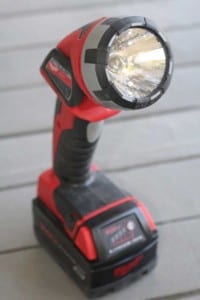
The light works with both the XC battery and the Compact battery. The only difference is the duration of the light output – which you can measure in hours, not minutes. It has a nice amount of rubber overmold and weighs 2 lbs, 4 oz with the included XC battery. This weight, plus the ample battery base means that it is fairly stable and can be set down without fear of blowing over from minor bumps.
Conclusion
There is simply no question that this new M18 18V combo kit from Milwaukee tools is comprised of a suite of solid performers. While we may not have gotten giddy over the Xenon light, the remaining three products are more than a little impressive and would be a fine addition to the professional contractor’s toolbox. For those do-it-yourselfers and hobbyists, you can pick this kit up as a top-notch product that will last you forever, or check out Milwaukee’s M12 line for reduced performance (not to mention weight) at a lower price point. This is a professional’s choice product and will neatly fit the contractor or homeowner who wishes to get the most possible power without jumping to the weight and additional bulk of the V28 system.
For our Performance rating we gave it an 8/10 because of all the immense power and quality features. For Value, we also rated it 7/10 since there is a lot of competition in the marketplace and some features are necessarily give and take. If you aren’t a Milwaukee fan, using these tools will make you one. If you are already a Milwaukee tool user and are upgrading, this is going to be a great experience.


